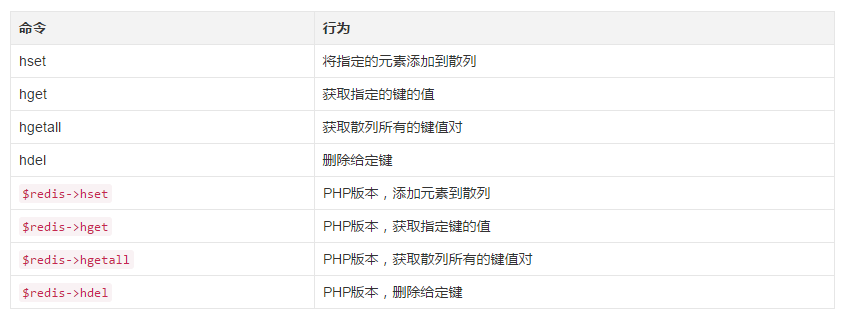PHP+Redis: hash hash type
3. Hash type
Introduction
Hash is similar to a small Redis database
A hash can contain multiple key-value pairs
Each key of the hash cannot be repeated and is different. Unordered arrangement
The value can be a string or a numeric value
For a numeric value, you can perform an increment or decrement operation
Hash structure
In the structure below, user represents the key name, which can contain multiple Different key-value pairs
[
"user":[
"name1":"yanying1",
"name2":"yanying2",
"name3":"yanying3"
]
]How-to

Demo (Command Line + PHP Demo)
Command Line:
First, we add a key-value pair to the hash. If successful, return 1; if the key already exists, return 0
hset hash-key sub-key1 value1 // 返回 1
We add a non-existent key-value pair
hset hash-key sub-key2 value2 // 返回 1
At this time, the keys sub-key1 and sub-key2 already exist in the hash, and then we add Add an identical key sub-key1 to the hash and see what happens:
hset hash-key sub-key1 value1 // 返回 0,由于该键已经存在
Below we get the value of a given key sub-key1 through hget.
hget hash-key sub-key1 // "value1"
Successfully obtained a value. Let’s get all the added elements to see which values were just added
hgetall hash-key
The results are as follows. We found that the first result is the key of the first key-value pair, the second result is the value of the key-value pair, and so on, with every two as a group.
"sub-key1""value1""sub-key2""value2"
Let’s try to delete a key. We will find that if the key previously existed in the hash, then 1 will be returned when deleting it. Otherwise, 0 will be returned.
hdel hash-key sub-key1 // 该键之前存在于散列,返回1
Let’s try to delete sub-key1 again, It is found that when deleting a non-existent key, the return result is 0
hdel hash-key sub-key1
We get all the key-value pairs again to see what is left.
hgetall hash-key
The result is that there are two less results. After all, a key-value pair has just been deleted
"sub-key1""value1"
PHP version demonstration
The first step is to link the redis database
$redis = new Redis();$redis->connect('127.0.0.1', 6379);
We first insert a key-value pair into hash-key hash. 1 means the insertion is successful; 0 element means it already exists
$redis->hset('hash-key','sub-key1','value1'); // int 1,元素插入成功,之前不存在该键
We insert the same key-value pair again
$redis->hset('hash-key','sub-key1','value1'); // int 0,元素插入失败,该键已经存在
For the following demonstration, we continue to insert some other values
$redis->hset('hash-key','sub-key2','value2'); // int 0
Now we use hget to get the value corresponding to the key. Let's try to get the value of sub-key2.
$redis->hget('hash-key','sub-key2'); // 'value2'
After getting one, we try to use hgetall to get all the values just inserted to see which key-value pairs are contained in it
$redis->hgetall('hash-key');
The result is an array containing the complete key value
array (size=2) 'sub-key1' => string 'value1' (length=6) 'sub-key2' => string 'value2' (length=6)
After viewing all the key values Right, let's try to delete one of the keys. If the key exists in the hash before, it returns 1. Otherwise, it returns 0
$redis->hdel('hash-key','sub-key1'); // 该键之前存在,返回int 1
We try to delete the sub-key1 key again and find that it returns 0. This means that the key does not exist in the set and the deletion failed
$redis->hdel('hash-key','sub-key1'); // 该键不存在,返回int 0
Next we Use hgetall to check all key-value pairs remaining in the hash
$redis->hgetall('hash-key');
and find that only an array containing one key-value pair is returned.
array (size=1) 'sub-key2' => string 'value2' (length=6)
The reason is that sub-key1 has just been deleted

Hot AI Tools

Undresser.AI Undress
AI-powered app for creating realistic nude photos

AI Clothes Remover
Online AI tool for removing clothes from photos.

Undress AI Tool
Undress images for free

Clothoff.io
AI clothes remover

AI Hentai Generator
Generate AI Hentai for free.

Hot Article

Hot Tools

Notepad++7.3.1
Easy-to-use and free code editor

SublimeText3 Chinese version
Chinese version, very easy to use

Zend Studio 13.0.1
Powerful PHP integrated development environment

Dreamweaver CS6
Visual web development tools

SublimeText3 Mac version
God-level code editing software (SublimeText3)

Hot Topics
 1386
1386
 52
52


